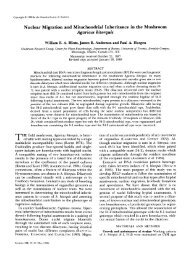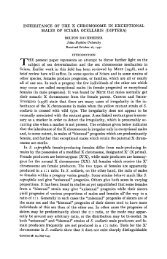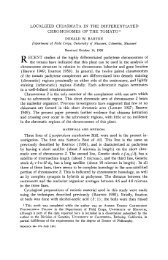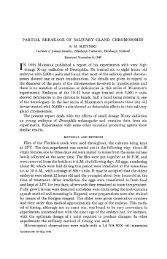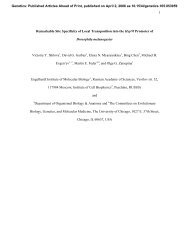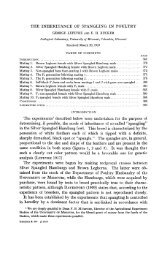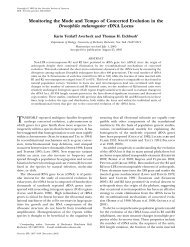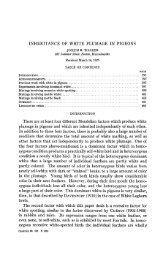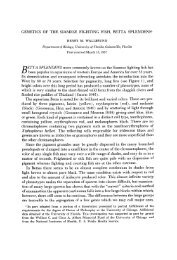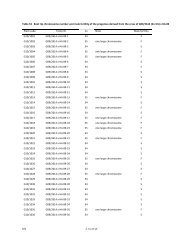abstracts of papers presented at the 1962 meetings - Genetics
abstracts of papers presented at the 1962 meetings - Genetics
abstracts of papers presented at the 1962 meetings - Genetics
You also want an ePaper? Increase the reach of your titles
YUMPU automatically turns print PDFs into web optimized ePapers that Google loves.
990 ABSTRACTS<br />
Four lines <strong>of</strong> genetically isol<strong>at</strong>ed turkeys (one random-bred, and three experimentals, each<br />
selected for a single trait), six gener<strong>at</strong>ions removed from a common base popul<strong>at</strong>ion, have<br />
demonstrable differences for several blood factors. When tested <strong>at</strong> Serology Labor<strong>at</strong>ory, Uni-<br />
versity <strong>of</strong> California, Davis, lines 3 and 4 (selected for egg production and h<strong>at</strong>chability, re-<br />
spectively) were found to be devoid <strong>of</strong> factor Q, common in lines 1 and 2 (random-bred and<br />
large-body size, respectively). Tests <strong>at</strong> WSU have revealed quantit<strong>at</strong>ive differences between<br />
lines 1 or 2 and lines 3 or 4 for F and M antigenic complexes: <strong>the</strong>re is rel<strong>at</strong>ively more M and<br />
less F in lines 1 and 2 than in lines 3 and 4. When antiturkey rabbit serum B, produced by<br />
injecting RBC from 2 to 4 month old turkeys (I), was, first, incompletely absorbed with RBC<br />
<strong>of</strong> (1) or <strong>of</strong> 10 to 12 month old turkeys (2), differences in RBC “absorption power” were re-<br />
vealed: RBC <strong>of</strong> (2) showed lower values. Reverse was true for antiturkey rabbit serum W, ob-<br />
tained by injecting (2) RBC and <strong>the</strong>n partially absorbing <strong>the</strong> serum with (1) or (2) RBC. A<br />
tent<strong>at</strong>ive explan<strong>at</strong>ion, supported by o<strong>the</strong>r rel<strong>at</strong>ed observ<strong>at</strong>ions <strong>at</strong> this labor<strong>at</strong>ory, is th<strong>at</strong> (2) RBC<br />
carry more M antigens and less F than (1 ) RBC. Thus, lines 1 and 2 are antigenically closer to<br />
(2)-type RBC and lines 3 and 4 to (1)-type RBC. (Project 1600, supported, in part, by funds<br />
provided for biological and medical research under St<strong>at</strong>e <strong>of</strong> Washington Initi<strong>at</strong>ive No. 171.)<br />
TANO, S., and A. B. BURDICK, Purdue University, Lafayette, Ind.: Female fecundity <strong>of</strong> Drosophila<br />
melanogaster second chromosome recessive lethal heterozygotes in homozygous and heterozygous<br />
genetic background.-Eighteen spontaneous lethals were introduced separ<strong>at</strong>ely to<br />
homozygous S-2 genetic background by a system which allowed an average <strong>of</strong> 13.7% residual<br />
heterozygosity from <strong>the</strong> original lethal stock, i.e., a section averaging 39.4 crossover units surrounding<br />
<strong>the</strong> lethal remained unsubstituted by S-2. Fifty l/+ females, divided into five replic<strong>at</strong>ions,<br />
were observed for egg production during <strong>the</strong> third through sixth days after eclosion.<br />
Heterozygous background was produced by crossing <strong>the</strong> S-2 background strains with W-109, an<br />
unrel<strong>at</strong>ed homozygote.-In homozygous background where <strong>the</strong> female fecundity (f) <strong>of</strong> S-2<br />
is taken <strong>at</strong> 1.000, <strong>the</strong> mean f <strong>of</strong> <strong>the</strong> 18 lethal heterozygotes was 1.475, all values being gre<strong>at</strong>er<br />
than 1.19. When <strong>the</strong> f values were corrected for <strong>the</strong> 13.7% residual heterozygosity, <strong>the</strong> mean<br />
f became 1.280 and only one <strong>of</strong> <strong>the</strong> 18 values fell below 1.0. Five <strong>of</strong> <strong>the</strong> corrected f values were<br />
considered to be significantly gre<strong>at</strong>er than 1.000, while <strong>the</strong> group as a whole could be considered<br />
to represent samples drawn from a popul<strong>at</strong>ion <strong>the</strong> over-all mean <strong>of</strong> which was gre<strong>at</strong>er than 1.000<br />
since 17 <strong>of</strong> <strong>the</strong> 18 values fell above 1.000.-1n heterozygous background, where <strong>the</strong> hybrid<br />
S-2/w-109 was taken as 1.000, <strong>the</strong> mean f value was 0.961, all values being less than 1.05, 11<br />
<strong>of</strong> <strong>the</strong>m less than 1.000. There was no rank order correl<strong>at</strong>ion between f values obtained from<br />
homozygous and heterozygous background.-Larval, or preadult, viability has been <strong>the</strong> usual<br />
means <strong>of</strong> estim<strong>at</strong>ing <strong>the</strong> consequences <strong>of</strong> heterozygosity for deleterious genes, whereas f is equally<br />
important in over-all fitness. The present study indic<strong>at</strong>es th<strong>at</strong> <strong>the</strong> f consequences are rel<strong>at</strong>ive to<br />
<strong>the</strong> degree <strong>of</strong> heterozygosity <strong>of</strong> <strong>the</strong> genetic background. (Supported by NIH E-1428.)<br />
TAUB, STEPHAN R., Harvard University, Cambridge, Mass.: The effect <strong>of</strong> nuclear genes on<br />
nuclear differenti<strong>at</strong>ion in syngen 7, Paramecium aure1ia.-A mutant strain (m7-1) restricted<br />
to m<strong>at</strong>ing type XI11 arose following ultraviolet irradi<strong>at</strong>ion <strong>of</strong> type XIV cells <strong>of</strong> a wild-type<br />
strain (d7-1) capable <strong>of</strong> expressing ei<strong>the</strong>r m<strong>at</strong>ing type XI11 or XIV. In <strong>the</strong> progeny <strong>of</strong> hybrids<br />
formed between <strong>the</strong> mutant and wild-type strains <strong>the</strong> restriction to type XI11 is observed to<br />
segreg<strong>at</strong>e in a 1 : 1 r<strong>at</strong>io from <strong>the</strong> ability to express ei<strong>the</strong>r type. Thus a mut<strong>at</strong>ion <strong>at</strong> a single locus<br />
is sufficient to account for <strong>the</strong> origin <strong>of</strong> m7-1. The mutant gene <strong>at</strong> this locus is design<strong>at</strong>ed n, its<br />
wild-type allele, N. The progeny <strong>of</strong> crosses <strong>of</strong> heterozygotes (N/n) on m<strong>at</strong>ing type XIV to<br />
stock 38, strain homozygous for mtxl11, a gene which, like n, restricts homozygotes to type<br />
XIII, are capable <strong>of</strong> expressing ei<strong>the</strong>r type XI11 or XIV. Breeding analyses <strong>of</strong> <strong>the</strong>se progeny<br />
reveal th<strong>at</strong> <strong>the</strong> N and mt loci are unlinked.-As is <strong>the</strong> case with homozygotes for mtXIII (TAUB,<br />
<strong>Genetics</strong> 44:541, 1959), progeny genically competent to express ei<strong>the</strong>r m<strong>at</strong>ing type which derive<br />
<strong>the</strong>ir cytoplasm from stock m7-1 (n/n) become type XIV. However, in contrast to <strong>the</strong> case <strong>at</strong><br />
<strong>the</strong> mt locus, genically competent cytoplasmic progeny <strong>of</strong> heterozygotes <strong>of</strong> type XI11 become





